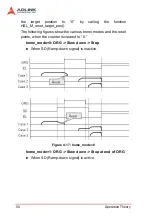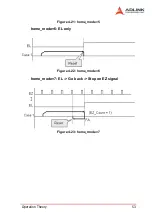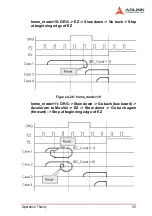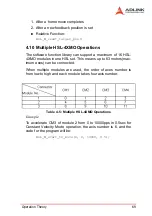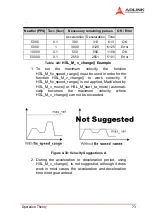
62
Operation Theory
X
Relative Functions:
HSL_M_Set_Servo()
HSL_M_get_io_status()
4.8 The Limit Switch Interface and I/O Status
In this section, the following I/O signal operations are described.
X
SD/PCS: Ramping Down & Position Change sensor
X
±
EL: End-limit sensor
X
ORG: Origin position
In any operation mode, if an ?EL signal is active during any mov-
ing condition, it will cause the HSL-4XMO to stop automatically
outputting pulses. If an SD signal is active during moving condi-
tions, it will cause the HSL-4XMO to decelerate. If operating in a
multi-axis mode, it automatically applies to all related axes.
SD/LTC
SD/LTC signal pins are available for each axis and acts as the
input channel. It can be connected to a SD (Slow Down) or Posi-
tion Latch (LTC).
This input pin is inside connected to both slow down function and
latch function. Users can control the slow down function to be
active or not. But the latch function is always turned on without any
problem. Care must be taken with the logic attributes of the signal
not being used.
The slow-down signals are used to force the output pulse (OUT
and DIR) to decelerate to and then maintain the StrVel when it is
active. The StrVel is usually smaller than MaxVel. This signal is
useful in protecting a mechanism moving under high speeds
toward the mechanism’s limit. SD signal is effective for both plus
and minus directions.
The ramping-down function can be enabled or disabled using the
software function HSL_M_set_sd(). The input logic polarity, level
operation mode, or latched input mode can also be set by this
function. The signal status can be monitored using
HSL_M_get_io_status().
Summary of Contents for HSL-4XMO
Page 4: ......
Page 16: ...6 Introduction ...
Page 36: ...26 Signal Connections ...
Page 67: ...Operation Theory 57 Home Search Example Home mode 1 Figure 4 29 Home Search Example ...
Page 108: ...98 Motion Creator in LinkMaster ...



